 Dr. Nelson Clements has some strong beliefs about cosmetic dentistry. He believes that his patients are the most important part of his practice. He believes that health and beauty in your smile go hand in hand. He believes that all the teeth in your mouth work together, and that they all should be healthy and beautiful. And be believes that the impacts of an unhealthy mouth can be felt throughout the body.
Dr. Nelson Clements has some strong beliefs about cosmetic dentistry. He believes that his patients are the most important part of his practice. He believes that health and beauty in your smile go hand in hand. He believes that all the teeth in your mouth work together, and that they all should be healthy and beautiful. And be believes that the impacts of an unhealthy mouth can be felt throughout the body.Adhering to these beliefs, Dr. Clements strives to deliver the best possible care to all his patients in Valdosta, GA, offering high-level dental care that you might think you have to travel to New York, Los Angeles, or Dubai to receive. If you want to learn more about the great dental care offered by cosmetic dentist, Dr. Nelson Clements, please call (229) 242-5511 or email today for an appointment.
Served areas
- Valdosta, Lowndes County
Highlights and features
- Cosmetic Dentistry
- Sleep Apnea
- Dentures
- Reconstructive Dentistry
Associations and certifications
- American Sleep & Breathing Academy
- American Academy of Dental Sleep Medicine
- SomnoMed
- The International College of Cranio-Mandibular Orthopedics
- Biolase
- International Academy of Oral Medicine & Toxicology
Services
Cosmetic Dentistry
Report
 Some people may think that the appearance of your smile is something frivolous, not worthy of attention, but there are many benefits of having an attractive smile.
Some people may think that the appearance of your smile is something frivolous, not worthy of attention, but there are many benefits of having an attractive smile. From a health perspective, it’s easier for us to identify decay or erosion on your teeth if they’re white.
From a social perspective, your smile is how most people will judge you. It’s the first thing they’ll notice about you, and the last thing they’ll forget. They will form impressions about your intelligence, income, health, and personality on the basis of your smile. A nice smile is the most important thing people are looking for in a potential mate, and it can dramatically impact your odds of getting a job, and what salary you’ll be offered.
People respond to your smile so strongly because smiling is as essential a function of your teeth as is chewing and helping with speech. Neglecting the appearance of your smile would be a dereliction of duty as a dentist.
Holistic Dentistry
Report
 Holistic dentistry means using only healthy materials for restorations. For centuries, dentistry offered two types of fillings: silver and gold. But while the gold fillings were really gold, the silver fillings were actually mostly mercury with other toxic metals like tin and copper. The practice started when mercury was commonly used in many applications, such as in hat-making. That’s probably the origin of the phrase “mad as a hatter”–hatters were driven insane by exposure to mercury in the 18th and 19th centuries. But while most industries gave up on toxic mercury, many dentists continue to use it to this day.
Holistic dentistry means using only healthy materials for restorations. For centuries, dentistry offered two types of fillings: silver and gold. But while the gold fillings were really gold, the silver fillings were actually mostly mercury with other toxic metals like tin and copper. The practice started when mercury was commonly used in many applications, such as in hat-making. That’s probably the origin of the phrase “mad as a hatter”–hatters were driven insane by exposure to mercury in the 18th and 19th centuries. But while most industries gave up on toxic mercury, many dentists continue to use it to this day. Although the American Dental Association (ADA) and the Food and Drug Administration (FDA) support the safety of mercury fillings, there are many things we do know about them that give us pause:
Mercury is highly toxic
Mercury doesn’t stay in the fillings–it moves throughout the body
Organisms in the body can change inorganic mercury to toxic methylmercury
People with mercury fillings have high levels of mercury in their blood
For these reasons, we believe that not only should dentists not place mercury fillings, but that these fillings should be removed.
Sleep Apnea Treatment Compliance
Report
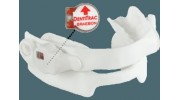 Sleep apnea treatment is highly effective, but only if you use it. Doctors recommend sleep apnea treatment, insurance companies pay for it, and employers count on it, but they may demand proof that you’re using it.
Sleep apnea treatment is highly effective, but only if you use it. Doctors recommend sleep apnea treatment, insurance companies pay for it, and employers count on it, but they may demand proof that you’re using it. Doctors back sleep apnea treatment because they know it’s effective. When an insurance company approves payment for a sleep apnea treatment, they are hoping that paying for it will actually save them money. That’s because they know that treating your sleep apnea will reduce your risk of other serious health conditions, including heart disease, stroke, and cancer.
Employers want you to get treatment for your sleep apnea because they know that what happens at night can have a dramatic impact on your performance during the day. Sleep apnea can increase your risk of workplace accidents. And because your employer might be paying for your health insurance, your compliance status might dramatically impact their insurance rates–and will definitely impact their costs if they are self-insured.
But the area where compliance is the most important is in transportation. Truckers, pilots, and train engineers have all been involved in serious accidents where sleep apnea was partly to blame. Now new regulation aimed at reducing these accidents is requiring more screening and more treatment for sleep apnea–and that means more verification.
In the past, only CPAP offered compliance data, which meant that any time insurance wanted verification you needed to use CPAP. But now that oral appliances can provide compliance recording, you have more options for comfortable, convenient treatment you’ll actually use.
Gum Recontouring
Report
 Some people may be reluctant to get gum recontouring because they are concerned about having such a sensitive area worked on. But laser recontouring is different from other gum procedures you might have had or seen in the past.
Some people may be reluctant to get gum recontouring because they are concerned about having such a sensitive area worked on. But laser recontouring is different from other gum procedures you might have had or seen in the past. With laser recontouring, there is little discomfort, little bleeding, and the procedure can be accomplished very quickly. Healing is fast, and there’s no lingering discomfort. Plus the laser is a precise tool, allowing Dr. Clements to get the precise contour you are looking for.
To learn more about the benefits of laser gum recontouring in Valdosta, GA, please call (229) 242-5511 or email for an appointment with Dr. Clements.
Gum Disease Treatment
Report
 The treatment for gum disease depends on the severity of the infection. For minor cases of gum disease, we might just recommend a wait-and-see approach combined with changes to your oral hygiene. For more serious gum disease, we will perform a procedure similar to root planing and scaling, but using a laser to facilitate treatment. This reduces discomfort, helps sterilize the treatment area, and can speed healing.
The treatment for gum disease depends on the severity of the infection. For minor cases of gum disease, we might just recommend a wait-and-see approach combined with changes to your oral hygiene. For more serious gum disease, we will perform a procedure similar to root planing and scaling, but using a laser to facilitate treatment. This reduces discomfort, helps sterilize the treatment area, and can speed healing. For very serious cases, we might refer you to a specialist for surgical management.
If you are looking for a Valdosta, GA dentist to help prevent or treat gum disease, please call (229) 242-5511 or email for an appointment with Dr. Nelson Clements.
Dental Bonding
Report
 We will have a consultation to discuss your desired results. If we think that dental bonding can fulfill your cosmetic goals, we will perform the procedure.
We will have a consultation to discuss your desired results. If we think that dental bonding can fulfill your cosmetic goals, we will perform the procedure. The first step in the procedure is we will prepare your teeth. Usually, this just means roughing the tooth to improve the connection between the bonding material and your tooth. Dental bonding uses the same composite resin that is used for many tooth-colored fillings. This material starts as a putty that can be shaped once it is placed on your tooth. Once we have achieved the desired shape, we will shine a special light on the resin, causing it to harden. Then the resin is polished.
Dental Implants
Report
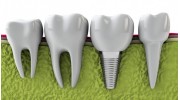 We perform a comprehensive exam of your mouth to determine if they are the right treatment for you. We might propose alternative treatments, such as a root canal to save threatened teeth, a dental bridge or even dentures, depending on the overall condition of your mouth.
We perform a comprehensive exam of your mouth to determine if they are the right treatment for you. We might propose alternative treatments, such as a root canal to save threatened teeth, a dental bridge or even dentures, depending on the overall condition of your mouth. If we decide that dental implants are the right procedure for you, we will determine what treatments might be necessary before placing your dental implant, such as gum disease treatment or a bone graft. We will use a number of imaging techniques to ensure that you have adequate bone density at the implant site.
When your jaw is ready to receive the dental implant, we will place it. At the time of placement, we will determine how stable the implant is. If the implant is very stable, it can support a dental crown or dental bridge immediately. With a less stable implant, we might place a healing abutment–like a metal cap that sits on top of the implant and holds space for the dental crown. If the implant is very unstable, we might cover the implant up with the gums and allow it to heal without interference.
At your follow-up visits we will monitor how well the dental implant is integrating into your bone. When osseointegration is adequate, we will place the final tooth restoration.
Headache & Migraine Treatment
Report
 Headaches are among the most common symptoms people suffer. Unfortunately, they can be caused by so many things that it can be hard to precisely diagnose the cause. In fact, many doctors don’t consider TMJ as a potential cause of headaches. If your doctor’s treatments haven’t been helping, maybe it’s time to see a neuromuscular dentist about them.
Headaches are among the most common symptoms people suffer. Unfortunately, they can be caused by so many things that it can be hard to precisely diagnose the cause. In fact, many doctors don’t consider TMJ as a potential cause of headaches. If your doctor’s treatments haven’t been helping, maybe it’s time to see a neuromuscular dentist about them. If you are looking for a neuromuscular dentist in Valdosta, GA, please call (229) 242-5511 or email for an appointment with Dr. Nelson Clements.
Sedation Dentistry
Report
 Sedation dentistry can help a lot of people who either have difficulty making it to the dentist or have an unpleasant experience at the dentist. You can benefit from sedation dentistry if you:
Sedation dentistry can help a lot of people who either have difficulty making it to the dentist or have an unpleasant experience at the dentist. You can benefit from sedation dentistry if you:Skip dental treatments due to anxiety or fear
Have a sensitive gag reflex
Have difficulty getting numb
Get pain in the jaw, neck, or back
Can’t sit still during dental appointments
Want extensive treatments but have difficulty with long appointments
Sedation dentistry helps people with anxiety feel relaxed and comfortable at dental appointments. Dental anxiety affects most people, even if they’re unaware that anxiety is the cause of their problems. Dental anxiety can keep you from making your regular dental appointments, but it can also cause many effects that make for unpleasant dental experiences.
For many people, a sensitive gag reflex can be related to anxiety making you hyper-aware of what’s going on in your mouth. Difficulty getting numb is often caused by high levels of anxiety, which cause your body to burn through the anesthetic. If you are sore after your dental appointment, that can also be caused by dental anxiety, which makes you tense up and keep your body tense throughout your appointment. And anxiety can also make it hard for you to sit through a dental appointment. With all the above problems, you may not even be aware that they are related to anxiety–you may not even think you have anxiety.
Sedation dentistry can also help if you’re looking for a smile makeover or other cosmetic dentistry procedure. The procedure might require a long appointment, longer than you’d be comfortable sitting through. Sedation can make it possible for you to make it through the appointment.
General Dentistry
Report
 Good oral hygiene is the backbone of general dentistry. Oral hygiene is divided into two parts: the part you undertake at home, and the part that we provide during your regular dental visits.
Good oral hygiene is the backbone of general dentistry. Oral hygiene is divided into two parts: the part you undertake at home, and the part that we provide during your regular dental visits. Home oral hygiene is the most important, because you practice it every day to help maintain the health of your teeth. You should brush twice a day for two minutes. Brush at night just before you go to bed. This helps protect your mouth overnight when saliva production drops and bacteria populations can increase. It’s also a good idea to brush in the morning to remove nightly accumulation. Brushing after breakfast can help by removing food particles that feed oral bacteria. If you want, you can brush during the day, too, after lunch. Always remember to wait half an hour after eating acidic foods or drinking acidic beverages before brushing. Brushing too often and too hard can injure your gums. It’s not necessary to brush after every time you eat.
Floss daily to help clean between your teeth. Make sure to curl the floss around your teeth and get the floss down to the gum line.
It’s also important to make your regular dental checkups. The benefits of visiting your dentist every six months include:
We can remove hardened plaque (calculus) that you can’t
We can safely polish your teeth so they look more attractive
We can check your teeth for decay before it becomes too damaging
We can identify shortcomings in home oral hygiene and recommend changes
All these will help prevent decay and infection of teeth so you can maintain a more healthy and attractive smile.
Root Canal Therapy
Report
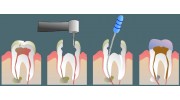 In a root canal treatment, we will first image the tooth and decide if the procedure is recommended. Then we will remove enough of the tooth enamel and dentin to allow us to access the interior of the tooth. Once inside the tooth, we will remove all the tooth pulp, including the infected tissue and the uninfected–because once compromised the tooth is vulnerable to future infection.
In a root canal treatment, we will first image the tooth and decide if the procedure is recommended. Then we will remove enough of the tooth enamel and dentin to allow us to access the interior of the tooth. Once inside the tooth, we will remove all the tooth pulp, including the infected tissue and the uninfected–because once compromised the tooth is vulnerable to future infection. Then we will fill the tooth with an inert, cushioning material that helps support the tooth but is resistant to infection. If necessary, we will also add a support post to help strengthen the tooth.
Once the procedure is complete, a temporary crown is placed while the permanent dental crown is completed. When the permanent crown is ready, the temporary is removed and the permanent one is placed.
Tooth-Colored Fillings
Report
 Tooth-colored fillings are growing in popularity because they offer many benefits, including:
Tooth-colored fillings are growing in popularity because they offer many benefits, including:Don’t stand out against teeth
Don’t oxidize and turn black
Actually bond with teeth, creating tight seal
Insulate better against hot and cold
Don’t expand or contract too fast with heat or cold
Don’t contain toxic mercury
Metal amalgam fillings start out silver, which means, at best, that people will be able to see you’ve had dental work done. Tooth-colored fillings are colored much closer to your natural teeth. Resin composite is a shade close to the color of your teeth, and may be mixed to match precisely. Porcelain inlays and onlays are precisely matched to the color of your teeth.
Metal amalgam fillings often oxidize (rust) and turn black. This means that your fillings will look as bad as–or worse than–the cavities they fill. Tooth-colored fillings don’t oxidize. Resin composite fillings can stain with exposure to coffee and other dark foods and beverages (similar to your tooth enamel, but faster) , but porcelain fillings are highly stain resistant.
Metal amalgam fillings are just stuffed into the hole drilled in your teeth. It’s expected that they’ll be held in by pressure against the sides of the hole. Resin composite and porcelain fillings are actually directly bonded to your teeth, creating a tight seal.
Metal isn’t a good insulator, which is why people with large metal fillings often have temperature sensitivity in those teeth. Resin and ceramic are both better insulators.
The problem with heat and cold isn’t just transmitting the temperature change to the center of the tooth and causing sensitivity. Heat makes materials expand and cold makes them contract. Unfortunately, metal amalgam does both much faster than tooth enamel. When exposed to cold, the filling can shrink, creating a gap around the filling that allows infiltration of liquid and bacteria. When exposed to heat, metal amalgam expands, pushing up against the tooth around the filling, contributing to sensitivity, but also potentially cracking the tooth.
Finally, it’s important to understand that metal amalgam is a bit of a euphemism: they’re really mercury amalgam fillings. These fillings are made of about 50% mercury by weight. Mercury is one of the most toxic elements known, and these fillings can potentially pose a serious health threat.
It is important to note that there is disagreement about just how toxic mercury from fillings can be. After all, it’s elemental mercury–the same kind found in thermometers and CFL bulbs–which is less toxic than methylmercury found in fish. The FDA and the ADA have both declared mercury fillings to be safe. However, we know several things about the mercury in fillings:
It doesn’t stay in the fillings
It accumulates in many parts of the body
Bacteria in the body can transform elemental mercury to more toxic forms
The EPA has repeatedly proposed tight regulations on how fillings are handled after being removed from the mouth
Many countries have banned metal amalgam fillings
There is a worldwide movement to ban metal amalgam fillings
Given this knowledge, we believe we cannot justify the use of metal amalgam fillings in our practice.
Dental Bridges
Report
 There are many good reasons why you might choose a dental bridge. This includes:
There are many good reasons why you might choose a dental bridge. This includes:Seeking full function
Not enough bone for a dental implant
Good opportunity to restore teeth next to a gap
Faster results
May cost less than a dental implant
A dental crown is a fully functional restoration. Because it’s permanently fixed in your mouth, you can use it to bite and chew normally, enjoying all of your favorite foods. It won’t interfere with speech or slip out at inappropriate times. This makes a dental bridge similar to da dental implant.
But where a dental bridge is different is that it doesn’t require bone in your jaw for support. Instead, it’s supported by your natural teeth, which are themselves safe in bone.
You might also choose a dental bridge when teeth next to a gap are damaged, decayed, or worn. Because a dental bridge is supported by dental crowns placed over these teeth, it’s an excellent opportunity to address both problems with one procedure.
A dental bridge can also be completed in less time. In some circumstances a dental implant may take six months or more to be completed, but a dental bridge can be completed in a month or so.
Usually, dental bridges and dental implants are comparable in price, but sometimes dental bridges may be cheaper.
Partial Dentures
Report
 Partial dentures are among the least favorite dental restorations among patients and dentists, but they are sometimes appropriate. Partial dentures are generally not favored because they:
Partial dentures are among the least favorite dental restorations among patients and dentists, but they are sometimes appropriate. Partial dentures are generally not favored because they:Offer poor function–can interfere with talking and chewing
Can damage teeth with hooks and clasps
Can be poorly secured
Can come out of place at inconvenient times
During your consultation, we will evaluate your tooth replacement needs and desires, including your budget restrictions. We will consider all the options available and recommend treatment options from optimal to adequate. This may include a partial denture if we think we can give you adequate appearance and function with it.
To learn more about your tooth replacement options, please call (229) 242-5511 or email for an appointment with Valdosta, GA cosmetic dentist Dr. Nelson Clements.
Teeth Whitening
Report
 Teeth whitening is a chemical process. We expose your teeth to a concentrated chemical solution, usually a form of peroxide, which breaks down the staining molecules that are trapped in your teeth. It is essentially the same mechanism that is used in over-the-counter remedies, but because we are able to handle the solution more carefully, we are allowed to use a stronger formula.
Teeth whitening is a chemical process. We expose your teeth to a concentrated chemical solution, usually a form of peroxide, which breaks down the staining molecules that are trapped in your teeth. It is essentially the same mechanism that is used in over-the-counter remedies, but because we are able to handle the solution more carefully, we are allowed to use a stronger formula. We use the most effective method for delivering the whitening solution. We create custom-made whitening trays for you. These fit precisely around your teeth and allow you to add whitening compound every night before you go to bed. The close fit of these trays ensures even contact with your teeth and allows for maximum effectiveness of whitening. After a few weeks, your teeth will be dramatically whiter. Because this approach gives gradual whitening, it’s more subtle. And it can make your teeth whiter than in-office whitening. Plus, it’s easy to maintain whitening this way–your results are essentially permanent.
Dental Crowns
Report
 Dental crowns are used whenever a tooth or restoration needs significant repair or support. Some of the common situations where dental crowns are used include:
Dental crowns are used whenever a tooth or restoration needs significant repair or support. Some of the common situations where dental crowns are used include:Heavily decayed tooth
Badly cracked tooth
Root canal
Covering or reshaping teeth when dental veneers aren’t enough
Support for dental bridge
Topping a dental implant
Adjusting bite as part of TMJ treatment
When a tooth has been weakened by decay–or by a large metal amalgam filling–it may be vulnerable to further damage that can lead to failure. To protect the tooth a dental crown is used.
Damage to a tooth is described as a crack rather than a chip when structurally significant damage has been done. Cracked teeth are vulnerable and benefit from protection with a dental crown.
When decay or a tooth crack has penetrated to the pulp chamber of a tooth, the interior of the tooth is exposed to infectious bacteria. To prevent further development of infection, a root canal is performed, and a dental crown is used to protect the treated tooth.
Sometimes dental crowns are used for cosmetic purposes. They may be used to conceal discolored teeth or reshape a small or poorly formed tooth like a retained baby tooth or peg lateral when dental veneers don’t cover enough or provide enough strength.
A dental bridge is a permanently bonded tooth replacement that is supported by your natural teeth. Dental crowns on your natural teeth are attached to the replacement tooth and bonded over the supporting teeth.
Technically, dental implant is only the metal root that is secured inside your jawbone. In order for a dental implant to look attractive, it needs to have a dental crown on top.
Dental crowns are strong enough that they can alter your bite. In the hands of many dentists, this can actually damage your bite, leading to many problems. In the hands of a neuromuscular dentist, they can alter your bite in a positive way, helping to treat TMJ and other bite problems.
Snoring Treatment
Report
 Snoring can be a serious danger to you and those around you. Possible risks of snoring include:
Snoring can be a serious danger to you and those around you. Possible risks of snoring include:Disputes and domestic violence
Falling asleep while driving
Sleep apnea
Atherosclerosis
Snoring can be very disruptive to a marriage. Some people cite it as a leading cause of divorce, and we know that it leads to terrible disputes and sometimes even domestic violence. A sleeping partner of a snorer loses about an hour a night of sleep due to snoring. A loss of sleep makes it harder to empathize with your partner, and makes it hard to have a reasonable discussion. This problem is made more serious because the snorer isn’t sleeping well, either. A refusal to get snoring treatment can often serve as a trigger that pushes a spouse over the edge, precipitating a violent attack.
Because snorers aren’t sleeping very well, they are more likely to fall asleep at the wheel. According to research by the Centers for Disease Control (CDC) , snorers are about 1. 5 times more likely to fall asleep at the wheel. The risk is compounded when you are also getting less sleep at night. In a survey, 8. 5% of drivers reported falling asleep behind the wheel if they said they snore and typically get 6 hours of sleep a night or less, compared to just 2% of drivers who didn’t snore and got 7-9 hours of sleep a night.
The danger of falling asleep at the wheel and getting in a car accident is even worse if you have sleep apnea. Snoring is the most common symptom of sleep apnea, and sleep apnea can increase your risk of being in a traffic accident up to five times. That’s in addition to cardiovascular risks, metabolic disorders, and psychological conditions associated with sleep apnea.
Implant Dentures
Report
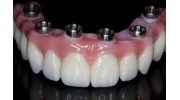 Our implant dentures offer all the benefits of dental implants and then some. They utilize some of the most advanced materials around to construct a restoration that is sturdy and attractive. Some of the benefits include:
Our implant dentures offer all the benefits of dental implants and then some. They utilize some of the most advanced materials around to construct a restoration that is sturdy and attractive. Some of the benefits include:Excellent function
Attractive appearance
Durability
Stability
Stain resistance
Stays cleaner
Hypoallergenic
Let’s face it: the main reason why you want to get a restoration with implants rather than with traditional unanchored dentures is because you want to get optimal function from your new teeth. They can do that for you. They will be secured with dental implants and can function just like natural teeth.
And they’ll look like natural teeth, too. The teeth are made of an advanced ceramic, zirconia, which better mimics the surface luster of natural teeth than acrylic teeth. And because they don’t need a metal substructure, there’s no metal to show through. You may have heard that zirconia isn’t as attractive as other ceramics used in cosmetic dentistry. But this formulation is amazing, a very attractive and very strong ceramic for use in implant dentures.
The high strength makes them very durable. They are resistant to chipping and cracking, so they’re less likely to need repairs in the near future and more likely to last a lifetime.
Because they are secured with dental implants that are anchored in the bone, they are very stable against all chewing and bite forces.
These implant dentures are made entirely of ceramic, so they are highly resistant to staining. The glaze on the bridge sheds staining compounds found in coffee, tea, wine, and other beverages. The smooth glaze also makes it hard for plaque to stick to the bridge, so they stay cleaner and are easier to clean by you.
And because they are made of a fully biocompatible ceramic, there’s no risk of allergic response as there sometimes is with plastics.
The Denture Fountain of Youth®
Report
 FOY® Dentures stand out from traditional ones when you compare them side by side. Economy dentures and many traditional ones come with a set of standard teeth. They look generic, and they have a flat appearance that looks either unnatural or very worn down. The teeth are often plastic. Sometimes, you may have the option of choosing between a few different styles of teeth on the dentures.
FOY® Dentures stand out from traditional ones when you compare them side by side. Economy dentures and many traditional ones come with a set of standard teeth. They look generic, and they have a flat appearance that looks either unnatural or very worn down. The teeth are often plastic. Sometimes, you may have the option of choosing between a few different styles of teeth on the dentures. But with FOY® Dentures, the teeth are fully customizable. Your teeth can be designed to match your youthful smile, or they can be the smile you’ve always dreamt of but never thought possible. They can have tiny flaws that give your smile personality, or they can be “Hollywood” perfect. It’s your choice. And the teeth are made of ceramic material, similar to the material used for porcelain veneers, so they’re beautifully natural–and very durable.
With economy and traditional dentures, the base is typically a flat plastic. It’s basically colored similar to natural gum tissue, but no one will mistake it for your true gums.
But with FOY® Dentures, the gums are created with the latest aesthetic techniques to make them look very natural. There is a complex layering effect that helps them look like natural gum tissue, as well as inclusion that mimic the blood vessels in natural gums.
Most dentures can pass for natural teeth if seen from a distance, but with FOY® Dentures, your teeth will look natural even if you get up close and personal.
Valdosta Porcelain Veneers
Report
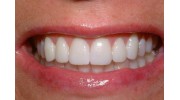 Porcelain veneers are the most powerful procedure in cosmetic dentistry. We aren’t exaggerating when we say that veneers can essentially give you an entirely new set of teeth. They can help if your teeth are:
Porcelain veneers are the most powerful procedure in cosmetic dentistry. We aren’t exaggerating when we say that veneers can essentially give you an entirely new set of teeth. They can help if your teeth are:Discolored
Chipped
Small or poorly shaped
Gapped
Crooked
Crowded
Rotated
And porcelain veneers can do a better job at treating these problems than competing treatments, too. Porcelain veneers can whiten teeth that teeth whitening can’t. And while teeth whitening results may last for months, porcelain veneers can last for years, even decades.
While dental bonding can help with chipped, small, or poorly shaped teeth, bonding lasts only a couple years while porcelain veneers can last a couple decades. And porcelain veneers look more natural than bonding, and are more stain resistant as well.
And while orthodontics can be used to close gaps in your teeth, straighten crooked teeth, and resolve crowding and rotated teeth, porcelain veneers can do it faster. Orthodontics takes a year or more. Porcelain veneers take a month or less–and you don’t have to wear a retainer.
Best of all, porcelain veneers can do it all in one procedure. People who get teeth whitening or orthodontics often find that correcting one problem reveals others. But with porcelain veneers, you get the exact smile you want.
Restorative Dentistry
Report
 As much as we try to take care of our teeth, we aren’t always able to keep them healthy and beautiful. Fortunately, restorative dentistry has many options for repairing your teeth and returning them to their beautiful, healthy state. Restorative dentistry can address minor cavities, teeth damaged by wear or trauma, and even hopeless or lost teeth.
As much as we try to take care of our teeth, we aren’t always able to keep them healthy and beautiful. Fortunately, restorative dentistry has many options for repairing your teeth and returning them to their beautiful, healthy state. Restorative dentistry can address minor cavities, teeth damaged by wear or trauma, and even hopeless or lost teeth. If you need restorative dentistry in Valdosta, GA, please call (229) 242-5511 or email for an appointment with Dr. Nelson Clements.
TMJ Treatment
Report
 Symptoms of TMJ
Symptoms of TMJOne of the things that can make TMJ both hard to diagnose and hard to live with is that it can cause a wide variety of symptoms. Some of the more common symptoms of TMJ include:
Jaw pain
Jaw muscle spasms
Jaw popping and clicking
Locked jaw
Headaches, including migraines
Damaged or worn teeth
Face pain
Tinnitus and earaches
Vertigo and dizziness
Neck pain
Upper back pain
Numbness or tingling in the hands and fingers
In addition, there is evidence linking TMJ to other chronic pain disorders, such as irritable bowel syndrome (IBS) and fibromyalgia. There is some suggestion that treating TMJ can help reduce or prevent these conditions, but that is controversial.
People

Nelson Clements, DMD
Owner/Dentist
Valdosta dentist Dr. Nelson Clements was about 20 years into his dental practice when he decided to radically reinvent his practice with one guiding principle: the patient should be at the center of his practice. He realized, as many of us have realized, that healthcare was coming to center more and more on insurance companies, which sometimes led to the marginalization of the patient.
Dr. Clements refocused his practice on the patient, which meant providing the quality of dental care that would truly be best for each patient. It also meant ensuring that his dental care harmoniously promoted the health of the whole mouth and the whole body.
Valdosta Dentist Dr. Nelson Clements
To help him achieve the high level of quality care he wanted to deliver, Dr. Clements has selected a highly professional staff of elite support personnel, all dedicated to the same ideals of patient-centered care and overall excellence. He has also ensure that both he and his staff have continued to remain educated so that our practice is at the leading edge of dentistry.
Dr. Clements refocused his practice on the patient, which meant providing the quality of dental care that would truly be best for each patient. It also meant ensuring that his dental care harmoniously promoted the health of the whole mouth and the whole body.
Valdosta Dentist Dr. Nelson Clements
To help him achieve the high level of quality care he wanted to deliver, Dr. Clements has selected a highly professional staff of elite support personnel, all dedicated to the same ideals of patient-centered care and overall excellence. He has also ensure that both he and his staff have continued to remain educated so that our practice is at the leading edge of dentistry.
Photos
Videos
Sleep Apnea | Nelson Clements, DMD
Learn how we can help at https://www.drnelsonclements.com/sleep-apnea!
Nelson Clements, DMD
(229) 242-5511
CPAP Alternative Testimonial Valdosta | Nelson Clements, DMD
Sleep apnea treatment testimonial for Dr. Nelson Clements in Valdosta, GA. A respiratory therapist who was unable to tolerate CPAP because of bloating, strap discomfort, and other problems, experienced great results with an oral appliance. Daytime sleepiness, snoring, and other problems were resolved with the much more comfortable and convenient alternative.
Oral Appliance Testimonial Valdosta | Nelson Clements, DMD
Nelson Clements, DMD
(229) 242-5511
drnelsonclements.com
2310 N Patterson St | Valdosta, GA 31602
Snoring Treatment Testimonial Valdosta | Nelson Clements, DMD
Snoring and sleep apnea testimonial for Dr. Nelson Clements in Valdosta, GA. A man who had a poor experience with CPAP found that an oral appliance allowed him to sleep well at night without snoring. And now he doesnt fall asleep during the day any more.
Snoring Testimonial Valdosta | Nelson Clements, DMD
Snoring and sleep apnea testimonial for Dr. Nelson Clements in Valdosta, GA. For two years, a woman struggled with CPAP following her apnea diagnosis, but got only partial relief. When she tried CPAP alternative oral appliance, she was able to sleep better and woke up well rested and comfortable. Plus she and her husband can now sleep in the same bed again because her snoring has been eliminated.
General Dentistry Valdosta | Nelson Clements, DMD
Dentist Nelson Clements in offers the most modern and comfortable general dentistry procedures to patients in Valdosta, GA. Dr. Clements can help people maintain an attractive smile, eliminate pain, and enjoy the freedom to eat a rich and varied diet comfortably.
Reviews (11)
Kathy Register
Allen Catoe
I have been going to see Dr. Clements since he opened his office on N. Patterson St. He and his staff have always treated me like family. I have a low-tolerance for gum pain and he and his staff always make sure I am as comfortable as possible. I have recommended several friends to Dr. Clements and will continue to do so. They are fantastic! Go see them. You will not be disappointed!
Scott James
Shauna Jarvis
Dr. Clements and his staff are a great group of people. He is a master at his craft and his staff is pleasant to work with. Going to the dentist is very unnerving for me but they all make the experience pleasant. If you are looking for a dentist, and appreciate one who's work is most like that of an artist, I highly recommend Dr. Clements. He does beautiful work.
Shawnna Jarvis
Dr. Clements is by far one of the best dentists I have ever had the pleasure of working with. His attention to detail shows in his results. Dr. Clements does the BEST work with the BEST labs around. Perfection is truly an understatement when discussing the quality of his dental work. Not only is his dental work over the top amazing, so is his mannerism.
It is nice to have a dentist that cares not only about your dental health but for you in general. He is very personal and sincere. I would recommend Dr. Nelson Clements to anyone looking for a dentist. He takes high end dentistry to another level.
It is nice to have a dentist that cares not only about your dental health but for you in general. He is very personal and sincere. I would recommend Dr. Nelson Clements to anyone looking for a dentist. He takes high end dentistry to another level.
Vicki Fletcher
Dr. Clements office and staff are not just a doctor and a bunch of nurses they are all Family! Dr. Clements is out sick right now and i am still under the greatest care. I pray daily for his recovery to go smoothly,and quickly. I also pray for his staff, because the good doctor keeps them and us patients in all a glow and laughter you never know what to expect except a great experience. Can you or any one else say that about their Family! Love you all!
Christy Chaney
Going to Dr. Clements has been one of the best decisions I have made medically in a long time. His staff is awesome. Dr. Clements treated me for a chronic sleep issue that I have dealt unsuccessfully for over 3 years. After going to see Dr. Clements and his staff I am resting better than I have in years. It has been amazing the difference in getting a good restful night of sleep can make in your life. No more chronic fatigue, I would without a doubt recommend Dr.Clements for anyone experiencing sleep disorders!
Danicka Lyrae
Dr. Clements is amazing. I have been going to him for my dental needs for three years. The staff are all warm hearted and understanding. They explain everything thoroughly and have alternative options for payment, which is fantastic. If you're looking for a friendly staff who know their stuff, you don't have to look anywhere else!
Hannah Weeks
My family and I love this place! The staff is always welcoming and friendly, and the wait to be seen has never been more than 5 minutes past appointment time (if that, even). My hygienist, Tanya, is always quick and efficient in anything she does (cleaning, X-Rays, etc.). Overall a pleasant experience!
Courtney Lipford
Sylvia Hutton
Dr. Clements has been my dentist for many years, and I have nothing but praise for him and the staff. Everyone is always friendly, professional, prompt. No waiting - hardly time to even sit down in the waiting room! All procedures are explained completely so there are no surprises! I would definitely recommend Dr. Clements and his staff to everyone.













